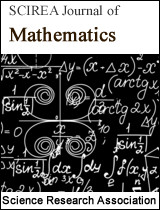The Reducibility of Modal Syllogisms Based on the Syllogism ▯EI◇O-2
DOI: 10.54647/mathematics110402 96 Downloads 160434 Views
Author(s)
Abstract
Syllogistic reasoning plays a crucial part in natural language information processing. For the purpose of providing a consistent interpretation for Aristotelian modal syllogistic, this paper firstly proves the validity of the syllogism EI◇O-2, and then takes it as the basic axiom to derive the other 38 valid modal syllogisms by taking advantage of some reasoning rules in classical propositional logic, the symmetry of two Aristotelian quantifiers (i.e. some and no), the transformation between any one of Aristotelian quantifiers and its three negative quantifiers, as well as some facts in first order logic. In other words, there are reducible relations between the modal syllogism EI◇O-2 and the other 38 valid modal syllogisms. There are infinitely many instances in natural language corresponding to any valid modal syllogism. Therefore, this study has theoretical value and practical significance for natural language information processing in computer science.
Keywords
Aristotelian syllogisms; Aristotelian modal syllogisms; Validity; Reducible relation
Cite this paper
Long Wei, Xiaojun Zhang,
The Reducibility of Modal Syllogisms Based on the Syllogism ▯EI◇O-2
, SCIREA Journal of Mathematics.
Volume 8, Issue 3, June 2023 | PP. 87-96.
10.54647/mathematics110402
References
| [ 1 ] | Long, W. (2023). Formal System of Categorical Syllogistic Logic Based on the Syllogism AEE-4. Open Journal of Philosophy, 13, 97-103. |
| [ 2 ] | Murinová, P., and Novák, V. (2012). A Formal Theory of Generalized Intermediate Syllogisms. Fuzzy Sets and Systems, 186, 47-80. |
| [ 3 ] | Hui, L. (2023) Reduction between categorical syllogisms based on the syllogism EIO-2. Applied Science and Innovative Research, 7, 30-37. |
| [ 4 ] | Cheng, Z. (2023). How to Deduce the Other 91 Valid Aristotelian Modal Syllogisms from the Syllogism IAI-3. Applied Science and Innovative Research, 7, 46-57. |
| [ 5 ] | Xiaojun Zhang. (2018). Axiomatization of Aristotelian syllogistic logic based on generalized quantifier theory. Applied and Computational Mathematics, 7(3), 167-172. |
| [ 6 ] | Łukasiewicz, J. (1957). Aristotle’s Syllogistic: From the Standpoint of Modern Formal Logic. Second edition, Oxford: Clerndon Press. |
| [ 7 ] | Striker, G. (1994). Assertoric vs. Modal Syllogistic. Ancient Philosophy, 14, 39-51. |
| [ 8 ] | Nortmann, U. (1996). Modale Syllogismen, mögliche Welten, Essentialismus: Eine Analyse der aristotelischen Modallogik. De Gruyter. |
| [ 9 ] | Brennan, T. (1997). Aristotle’s Modal Syllogistic. A Discussion of R. Patterson, Aristotle’s Modal Logic. Oxford Studies in Ancient Philosophy, 15, 207-231. |
| [ 10 ] | Smith, R. (1995). The Cambridge Companion to Aristotle, Cambridge University Press. |
| [ 11 ] | Chellas, F. (1980). Modal Logic: an Introduction. Cambridge University Press. |
| [ 12 ] | Chagrov, A. and Zakharyaschev, M. (1997). Modal Logical. Clarendon Press, Oxford. |
| [ 13 ] | Peters S., and Westerståhl, D. (2006). Quantifiers in Language and Logic. Claredon Press. |
| [ 14 ] | Xiaojun, Z. (2014). A Study of Generalized Quantifier Theory. Xiamen University Press. (in Chinese) |
| [ 15 ] | Malink, M. (2013). Aristotle’s Modal Syllogistic, Harvard University Press. |
| [ 16 ] | Moss, L. S. (2008). Completeness Theorems for Syllogistic Fragments. In F. Hamm, & S. Kepser (Eds.), Logics for Linguistic Structures. Mouton de Gruyter. |
| [ 17 ] | Xiaojun, Z. (2020). Screening out All Valid Aristotelian Modal Syllogisms. Applied and Computational Mathematics, 8, 95-104. |
| [ 18 ] | Johnson, F. (1989). Models for Modal Syllogisms. Notre Dame Journal of Formal Logic, 30, 271-284. |

